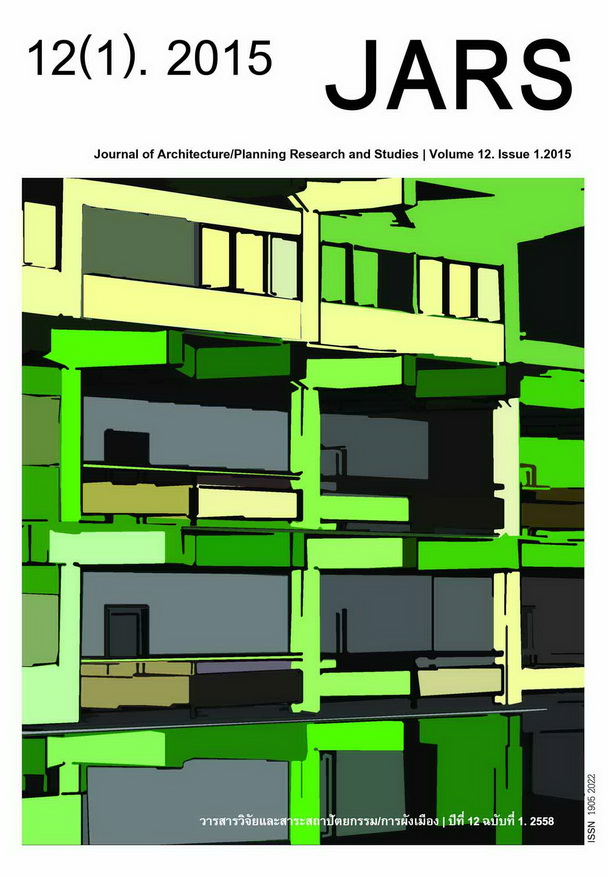Integrated Tensile Fabric Curved-Ceiling with Lightshelf for Daylight Performance in Office
Main Article Content
Abstract
This research presented the optimization of lightshelf performance with curved ceiling geometries. Aninnovative design of Polyester - PVC Fabric curved ceiling using tensile structure for the purpose of applyingto existing rooms are designed, developed and tested using simulation models in DIALux. The Illuminancelevel, the reach of daylight admission, the distribution uniformity and the visual quality using luminance ratiowere assessed on a working plane of commonly found open-plan office spaces with the depth of 8 meters ormore. The Polyester PVC fabric optical properties are as followed; visible reflectance (e) 0.88, and visibletransmittance 0.07 (t). The study compared the results of a room installed with lightshelf (internal 0.5 m., andexternal 1.00 m.) and the regular ceiling to the room with tensile fabric curved ceiling of 4 types, 1) concavecurve facing openings 2) concave curve facing away from openings 3) convex curve facing openings and 4)convex curve facing away from openings. The radius of the curvature and the installation dimension affectingthe daylight performance are also studied. The application of the ceiling's tensile structure with the benefit ofits lightweight is presented. The simulation results shown that the ceiling form of concave curve facing intothe room are the best geometries to increase the reach of daylight deeper into the space for 1 meter morewith more uniformity.
Downloads
Article Details

This work is licensed under a Creative Commons Attribution-NonCommercial-NoDerivatives 4.0 International License.
All material is licensed under the terms of the Creative Commons Attribution 4.0 International (CC-BY-NC-ND 4.0) License, unless otherwise stated. As such, authors are free to share, copy, and redistribute the material in any medium or format. The authors must give appropriate credit, provide a link to the license, and indicate if changes were made. The authors may do so in any reasonable manner, but not in any way that suggests the licensor endorses you or your use. The authors may not use the material for commercial purposes. If the authors remix, transform, or build upon the material, they may not distribute the modified material, unless permission is obtained from JARS. Final, accepted versions of the paper may be posted on third party repositories, provided appropriate acknowledgement to the original source is clearly noted.
References
Edmonds, I. R. & Greenup, P. J. (2002). Daylighting in the tropics. Solar Energy, 73(2), 111-121. doi: http://dx.doi.org/10.1016/S0038-092X(02)00039-7
Freewan, A. A., Shao, L. & Riffat, S. (2008). Optimizing performance of the lightshelf by modifying ceiling geometry in highly luminous climates. Solar Energy, 82(4), 343-353. doi: http://dx.doi.org/10.1016/j.solener.2007.08.003
Freewan, A. A. (2010). Maximizing the lightshelf performance by interaction between lightshelf geometries and a curved ceiling. Energy Conversion and Management, 51(8), 1600-1604. doi: http://dx.doi.org/10.1016/j.enconman.2009.09.037
Heschong Mahone Group. (2003). Windows and offices: A study of office worker performance and the indoor environment daylight and productivity. Fair Oaks, CA.
IESNA. (2010). The IESNA lighting handbook, 10th Edition. New York: IESNA.
Kim, G. Y. (2009). Performance analysis and design guidelines for lightshelves (Master). Pennsylvania State University, University Park, PA.
Knippers, J., Cremers, J., Gabler, M. & Lienhard, J. (2011). Construction Manual for Polymers+Membranes: Materials, Semi-finished Products, Form-Finding, Design. Basel: Birkhèauser Verlag.


